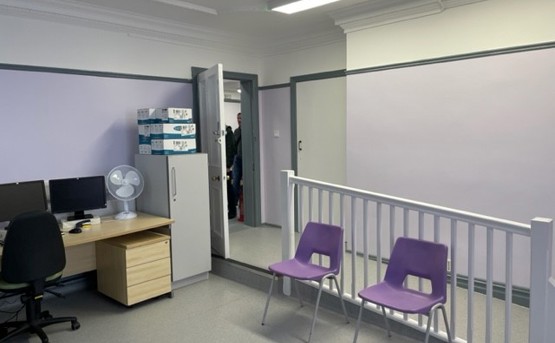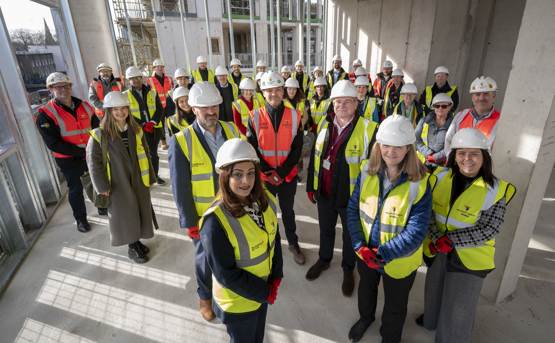
Published date: 18 May 2021
Optimising space in the NHS estate
Last month Simon Taylor, our Director of Portfolio Optimisation, presented a session on estate optimisation at the HSJ Strategic Estates Summit. In this blog he shares his key points and considerations from the session.
This article was originally published in the HSJ, you can read it here.
Estate planning and optimisation across health and social care is both essential and complex. It is important that the NHS infrastructure aligns with, and reflects, both the specific needs of each community, the Integrated Care Systems (ICSs) footprint and the national NHS Long Term Plan. Therefore, collaboration with newly formed ICSs and local property teams, in addition to regular community engagement, will be crucial in order to create a health estate that will help the NHS better serve patients; today and tomorrow. We need to work together, collaborate across organisations and geographies and optimise all of our estate capacity and capability – whether national, regional or local – to rapidly make changes to support improvements to the health infrastructure for patients and our workforce.
To meet the ever-changing demand for space across the NHS, capacity and changes will need to be created through new developments or reconfiguring and improving utilisation of existing buildings. As property advisors and owners of 10% of the NHS estate, NHS Property Services (NHSPS) worked alongside the NHS to help them meet urgent demand for space throughout the pandemic, whether it was through rapidly adapting current buildings to protect other patients and NHS staff from COVID-19, converting occupied sites into vaccination hubs, or recommissioning vacant or underused space to create additional bed, testing and vaccination capacity. For example, at a community hospital, we were tasked with identifying and preparing additional space to support the COVID-19 vaccination roll out; all in the space of two weeks. This meant quickly assembling our project team, as well as a network of external contractors, to repurpose former ward space into clinical areas for use as a vaccination clinic for three local GP practices. Working together with the local primary care network and clinical commissioning group, our facilities management team installed LED lighting upgrades, replaced flooring in clinical areas, completed multiple deep cleans and even erected a marquee to provide shelter for patients awaiting vaccination. It is vital that urgent demands for space are met swiftly and, through identifying the potential of under-utilised space and collaborating with the local health system, this can be achieved. When we no longer see a need for these types of services, it will be important for us to determine the best use of these newly transformed spaces, whether that’s for additional primary care services, community-based initiatives such as social prescribing or as longer-term contingency spaces.
Optimising the health estate is an everchanging challenge that we will continue to face beyond the COVID-19 pandemic. As such, it is important to continue to anticipate patient need and provide innovative solutions so that our customers, and the public can get the most out of the estate. One such solution is NHS Open Space. Launched in April 2019 following a two-year pilot, NHS Open Space helps to optimise the core estate across the NHS. The idea for NHS Open Space came about when we analysed our sites across England and saw that some of our spaces were not being consistently occupied. We wanted to change this, so we came up with a simple solution: if space is not being used to full capacity by existing NHS occupiers, we should make it more readily available for other NHS bodies and wider health and wellbeing services to rent on a flexible pay-as-you-go scheme. Not only does this make better use of the estate and mean communities can access more services from one local hub, it provides flexibility to different providers, and helps generate money which can be reinvested directly back into the NHS. This has been particularly important in the past year when estate flexibility and effectiveness have been so essential for the health service.
In order to determine future estate requirements infrastructure, it is vital that we have comprehensive estates data to support estate planning and decision making. This data also needs to be supported by local stakeholders to deepen and clarify our understanding of the estate, locality requirements and enable the development of appropriate and effective solutions. To achieve this, we will need to ensure there is increased integration of existing data and ensure all systems have common definitions, ownership and data quality checks. In addition, by using business intelligence analytics we can focus specifically on outputs, and we are supporting a nationwide Primary Care Data Gathering Programme that is being led by Community Health Partnerships for NHSE&I.
Whether reconfiguring space or building new structures, the opportunity to make the NHS estate greener when making property decisions should be seized. We have a key role to play in supporting the health service to reach its goal of achieving net zero carbon by 2040, so we will need to be ambitious with the Greener NHS agenda. For example, in addition to switching our entire building portfolio to 100% renewable electricity in April last year, over 50 of our sites so far have been upgraded to LED lighting. Between 2019 and 2020, the upgrade of 30 sites to LED lighting resulted in a saving of £550,000 and the equivalent of 830 tonnes of carbon dioxide. When building new developments, we have been reviewing how we can make these net zero carbon. We recognise however that achieving net zero carbon will only be achieved by making changes to the existing estate at scale and this is something we are passionate about doing through our capital and customer projects, but also in our day-to-day activities.
Investment will be needed to ensure that NHS infrastructure is aligned with local needs and the national health strategy. As such, a robust investment plan that draws on all capital sources needs to be developed. This could be achieved through maximising capital routes from disposals, s106 and Community Infrastructure Levies. Additionally, alongside the infrastructure investment, making small changes to primary care that have a big impact on patients and the NHS workforce will be important. With the increasing needs of social care, and the toll that the pandemic has taken on the mental health and wellbeing of communities across England, solutions such as social prescribing and green spaces will be needed to support wellbeing and improve health at a local level.
Optimising the health estate to meet the needs of patients will help build a healthier future. Maintaining a collaborative working culture across the NHS will be key to this process. During the pandemic, we have had to rapidly transform space to ensure that it is safe and fit-for-purpose for patients. As the pandemic relents, patient need will inevitably change. Through the development of initiatives like our ‘Healthy Places’ programme, which maximises national and regional expertise and supports relationship building with local delivery teams, we are ready to provide high quality and responsive services, which help the health service provide excellent patient care. Irrespective of organisational boundaries, we need empowered and engaged people with property expertise and know how to help ICSs adapt and innovate to get things done.
Want to learn more?
From high-level estate strategy to day-to-day property management, we are working to improve healthcare environments, deliver best value for the NHS, and enable excellent patient care.
Through active asset management we identify opportunities to increase the utilisation and value of the primary care estate. We optimise occupation, reduce costs and add value from the repurposing, sale, and development of surplus NHS land, so value released can be reinvested back into the NHS estate.






